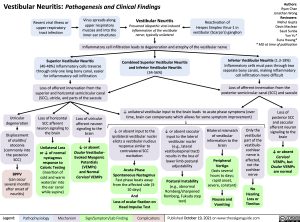Vestibular Neuritis: Pathogenesis and Clinical Findings
Authors: Ryan Chan Jonathan Wong Reviewers: Mehul Gupta Davis Maclean Saud Sunba Yan Yu* Euna Hwang* * MD at time of publication
Recent viral illness or upper respiratory tract infection
Virus spreads along upper respiratory mucosa and into the inner ear structures
Vestibular Neuritis
Presumed idiopathic viral-induced inflammation of the vestibular nerve; typically unilateral
Reactivation of Herpes Simplex Virus-1 in vestibular (Scarpa’s) ganglion
Inflammatory cell infiltration leads to degeneration and atrophy of the vestibular nerve
Superior Vestibular Neuritis
(40-48%) Inflammatory cells traverse through only one long bony canal, easier for inflammatory cell infiltration
Loss of afferent innervation from the superior and horizontal semicircular canal (SCC), utricle, and parts of the saccule
Combined Superior Vestibular Neuritis and Inferior Vestibular Neuritis (34-56%)
Inferior Vestibular Neuritis (1.3-18%) Inflammatory cells must pass through two separate bony canals, making inflammatory cell infiltration more difficult
Loss of afferent innervation from the posterior semicircular canal (SCC) and saccule
Utricular degeneration
Displacement of otoliths/ otoconia (commonly into the posterior SCC)
BPPV
(can occur several months after onset of neuritis)
Loss of horizontal SCC afferent neuron signaling to the brain
Unilateral Loss or ↓ of normal nystagmus response to Caloric Testing (insertion of cold and warm water/air into the ear canal while supine)
Loss of utricular afferent neuron signaling to the brain
↓ or absent Ocular Vestibular- Evoked Myogenic Potentials (VEMPs)
and Normal Cervical VEMPs
↓ unilateral vestibular input to the brain leads to acute phase symptoms (over time, brain can compensate which allows for some symptom improvement)
Loss of posterior SCC and saccular afferent neuron signaling to the brain
↓ or absent
Cervical
VEMPs, but Ocular VEMPs are normal
↓ or absent input to the ipsilateral vestibular nuclei elicits a vestibular nucleus response similar to contralateral SCC excitation
Acute-Phase Spontaneous Nystagmus Fast phase beats away from the affected side (3- 10 days)
And
Loss of ocular fixation on Head Impulse Test
↓ or absent saccular input to the lateral vestibular nuclei (e.g., lateral vestibulospinal tract) results in the loss of lower limb postural adjustability
Postural Instability
(e.g., abnormal Romberg/sharpened Romberg, Fukuda step test)
Bilateral mismatch of vestibular
information to the brain
Peripheral Vertigo (lasts several hours to days; rapid onset, severe, constant)
Nausea and Vomiting
Only the vestibular
part of the vestibulo- cochlear nerve is affected, not the cochlear nerve
No Hearing
Loss or Tinnitus
Legend:
Pathophysiology
Mechanism
Sign/Symptom/Lab Finding
Complications
Published October 19, 2021 on www.thecalgaryguide.com

